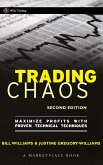David Nassar
Ordinary People, Extraordinary Profits
How to Make a Living as an Independent Stock, Options, and Futures Trader
David Nassar
Ordinary People, Extraordinary Profits
How to Make a Living as an Independent Stock, Options, and Futures Trader
- Gebundenes Buch
- Merkliste
- Auf die Merkliste
- Bewerten Bewerten
- Teilen
- Produkt teilen
- Produkterinnerung
- Produkterinnerung
Bestselling author and experienced trader and instructor David Nassar delivers a complete and proven system for aggressively and successfully trading in today's markets. Ordinary People, Extraordinary Profits explains the fundamentals of technical analysis and risk management to give readers a solid foundation to approach the market. Then Nassar describes a variety of trading strategies to make consistently large profits without taking undue risk. Unlike other trading advisors who advocate a single approach to trading, Nassar gives readers a variety of strategies that they can choose from to…mehr
Andere Kunden interessierten sich auch für
![Warrior Trading Warrior Trading]() Clifford BennettWarrior Trading42,99 €
Clifford BennettWarrior Trading42,99 €![Trade Like a Hedge Fund Trade Like a Hedge Fund]() James AltucherTrade Like a Hedge Fund61,99 €
James AltucherTrade Like a Hedge Fund61,99 €![Financial Risk Taking Financial Risk Taking]() Mike ElvinFinancial Risk Taking102,99 €
Mike ElvinFinancial Risk Taking102,99 €![Trade IPOs Online Trade IPOs Online]() Matthew D. ZitoTrade IPOs Online16,99 €
Matthew D. ZitoTrade IPOs Online16,99 €![J. Christoph Amberger's Hot Trading Secrets J. Christoph Amberger's Hot Trading Secrets]() J. Christoph AmbergerJ. Christoph Amberger's Hot Trading Secrets21,99 €
J. Christoph AmbergerJ. Christoph Amberger's Hot Trading Secrets21,99 €![Options on Futures Workbook Options on Futures Workbook]() John F. SummaOptions on Futures Workbook41,99 €
John F. SummaOptions on Futures Workbook41,99 €![Trading Chaos Trading Chaos]() Justine Gregory-WilliamsTrading Chaos64,99 €
Justine Gregory-WilliamsTrading Chaos64,99 €-
-
-
Bestselling author and experienced trader and instructor David Nassar delivers a complete and proven system for aggressively and successfully trading in today's markets. Ordinary People, Extraordinary Profits explains the fundamentals of technical analysis and risk management to give readers a solid foundation to approach the market. Then Nassar describes a variety of trading strategies to make consistently large profits without taking undue risk. Unlike other trading advisors who advocate a single approach to trading, Nassar gives readers a variety of strategies that they can choose from to fit their own comfort levels. In addition, Nassar explains how to use new trading instruments such as E-Mini contracts, options, and exchange-traded funds. For people looking for a complete, proven system for aggressively trading the stock market, this book is an ideal guide.
Hinweis: Dieser Artikel kann nur an eine deutsche Lieferadresse ausgeliefert werden.
Hinweis: Dieser Artikel kann nur an eine deutsche Lieferadresse ausgeliefert werden.
Produktdetails
- Produktdetails
- Wiley Trading Series
- Verlag: Wiley & Sons
- 1. Auflage
- Seitenzahl: 288
- Erscheinungstermin: 1. Juli 2005
- Englisch
- Abmessung: 235mm x 157mm x 22mm
- Gewicht: 485g
- ISBN-13: 9780471723998
- ISBN-10: 0471723991
- Artikelnr.: 14826844
- Herstellerkennzeichnung
- Libri GmbH
- Europaallee 1
- 36244 Bad Hersfeld
- gpsr@libri.de
- Wiley Trading Series
- Verlag: Wiley & Sons
- 1. Auflage
- Seitenzahl: 288
- Erscheinungstermin: 1. Juli 2005
- Englisch
- Abmessung: 235mm x 157mm x 22mm
- Gewicht: 485g
- ISBN-13: 9780471723998
- ISBN-10: 0471723991
- Artikelnr.: 14826844
- Herstellerkennzeichnung
- Libri GmbH
- Europaallee 1
- 36244 Bad Hersfeld
- gpsr@libri.de
David S. Nassar is founder and CEO of MarketWise.com, LLC, and a pioneer in electronic trading. He has been seen on CNBC, NBC Nightly News, and CNN, and interviewed in numerous national publications, including the Wall Street Journal, BusinessWeek, and Forbes. Nassar is also a New York Times bestselling author.
Preface.
Acknowledgments.
INTRODUCTION.
Trade the Professional Way.
Ride the Statistical Edge . . . Like Betting Seven in Craps.
Master the Inner Game.
CHAPTER 1 Foundational Analysis.
Charts.
Two Types of Analysis.
What Exactly Is Technical Analysis?
The Four-Stage Theory.
Stage 1: Accumulation.
Stage 2: Markup.
Stage 3: Distribution.
Stage 4: Decline.
Support and Resistance.
Definitions of Support and Resistance.
Once Broken, Support Tends to Act as Resistance.
Once Broken, Resistance Tends to Act as Support.
The More Often Support or Resistance Is Tested, the More Likely That Level
Is to Fail to Hold Back Price Movement.
The Longer the Trend Has Been Neutral (Consolidating), the More Significant
the Eventual Breakout Becomes.
Trends.
Trading Volume.
Moving Averages.
CHAPTER 2 Risk Management.
Discipline-The Key to Trading Success.
Discipline Perspectives.
Avoid Trading with Scared Money.
Terra Nova Trade Evaluator.
Your Goal: To Trade without Emotion.
Plan Your Trade and Trade Your Plan with Risk-Reward Ratios.
Setting Stops-Overview.
Overall Protective Stop Guidelines.
Protective Stops and Trading Time Frames.
Percentage of Price Stops.
Time Stops.
Avoid This Mistake.
RealTick® Can Help.
Risk Management and Trading with the News.
Risk Management and Share Size.
Summary.
CHAPTER 3 Basic Chart Formations.
Time Frames.
Weekly Charts.
Daily Charts.
Intraday Charts.
Sixty-Minute Charts.
Ten-Minute Charts.
Interpreting Chart Patterns.
Reversal Patterns.
Head and Shoulders Chart Formation.
Long Base and Saucer Formations.
Saucer Bottoms and Tops.
Cup and Handle Formation.
Bull and Bear Traps.
Continuation Patterns.
Rectangle (Box).
Flags and Pennants.
Triangles.
Summary.
CHAPTER 4 Going Short.
Finding Shorting Opportunities.
Price/Earnings Ratio Imbalance.
Gap Openings.
The Loaded Spring.
Day-Trading "Tape Resistance".
The Short Squeeze (Be Cautious).
Margin Accounts.
The Federal Reserve Board's Regulation T.
Opening a Margin Account.
Calculating Initial Requirements.
Excess Equity.
Calculating Maintenance Requirements.
Minimum Maintenance Requirements.
Change in Market Value.
Short Sales and Margin Requirements.
NASD/NYSE Minimum Deposit on Short Sales.
Margin Maintenance Calls on Short Sales.
Shorting-against-the-Box.
Summary.
CHAPTER 5 Other Trading Vehicles.
What Is an E-Mini S&P 500 Contract?
E-Mini Symbols.
Initial and Maintenance Margin Requirements.
Treatment of Settlement.
The E-Mini Contract versus the Pit-Traded Contract.
Price and Percentage Limits.
Single-Source Liquidity.
E-Mini Standard & Poor's 500 as a Hedge.
Tax Advantages with the E-Mini.
The E-Mini Nasdaq 100.
Chicago Board of Trade Mini-Dow Futures Use $5 Multiplier.
Who Regulates Futures Trading?
Program Trading and Fair Value.
Predicting the Opening.
How to Calculate Fair Value.
What about Exchange-Traded Funds?
The QQQQs.
E-Mini Is Hard to Beat.
Put and Call Options.
A Brief History.
Puts and Calls and Standardized Options.
Shares per Option.
Pricing.
Symbology.
Settlement.
In-the-Money or Out-of-the-Money.
Rights versus Obligations.
Opening and Closing Transactions.
Open Interest.
Opening Rotation.
Option Positions.
Long Stock.
Short Stock.
Long Call.
Short Call.
Long Put.
Short Put.
Conversions, Reversals, and Synthetics.
The Greeks and Delta Value.
Position Delta.
Gamma.
Position Gamma.
Long/Positive Gamma.
Short/Negative Gamma.
Omega.
Vega.
Theta.
Summary.
CHAPTER 6 Trading Strategies.
The Profiler's-Systems Trading.
Pricing Puts/Calls-A Strategy You Can Use.
CHAPTER 7 Indicators and Oscillator.
Stochastics.
Stochastics-Interpretation.
Relative Strength Index.
ARMS Index.
Using the TRIN.
Fibonacci Retracements.
CHAPTER 8 Traditional Pivot Analysis.
The Pivot Formula.
The Pivot in Action.
Calculating Pivots.
Choosing the Right Data for Calculations.
The Area between R1 and S1.
Illustrating Pivot Lines on RealTick.
Archiving Pivot Levels.
Pivotal Psychology.
Paper Trading.
Strategy and Money Management.
Lining Up Levels on Multiple Time Frames.
Trading a Confluence Zone.
Swing Trading with Confluence Areas.
Summary.
CHAPTER 9 Planning and Staying on Track.
What Is Your Time Commitment?
How Will You Fund Your Trading Account?
What Style of Trading Will You Pursue?
What Are Your Profit Objectives?
How Will You Manage Your Profits?
Do You Evaluate All Your Trades?
Are You Keeping a Journal?
Summary.
CHAPTER 10 Your Path to Success.
Where to Next?
Summary.
Appendix: MarketWise Tools-Routes to Success.
MarketWise Web Site Resources.
Tuning to the Market Intraday.
Glossary.
Bibliography and Exchange Contact Information .
Exchange Contact Information.
Index.
Acknowledgments.
INTRODUCTION.
Trade the Professional Way.
Ride the Statistical Edge . . . Like Betting Seven in Craps.
Master the Inner Game.
CHAPTER 1 Foundational Analysis.
Charts.
Two Types of Analysis.
What Exactly Is Technical Analysis?
The Four-Stage Theory.
Stage 1: Accumulation.
Stage 2: Markup.
Stage 3: Distribution.
Stage 4: Decline.
Support and Resistance.
Definitions of Support and Resistance.
Once Broken, Support Tends to Act as Resistance.
Once Broken, Resistance Tends to Act as Support.
The More Often Support or Resistance Is Tested, the More Likely That Level
Is to Fail to Hold Back Price Movement.
The Longer the Trend Has Been Neutral (Consolidating), the More Significant
the Eventual Breakout Becomes.
Trends.
Trading Volume.
Moving Averages.
CHAPTER 2 Risk Management.
Discipline-The Key to Trading Success.
Discipline Perspectives.
Avoid Trading with Scared Money.
Terra Nova Trade Evaluator.
Your Goal: To Trade without Emotion.
Plan Your Trade and Trade Your Plan with Risk-Reward Ratios.
Setting Stops-Overview.
Overall Protective Stop Guidelines.
Protective Stops and Trading Time Frames.
Percentage of Price Stops.
Time Stops.
Avoid This Mistake.
RealTick® Can Help.
Risk Management and Trading with the News.
Risk Management and Share Size.
Summary.
CHAPTER 3 Basic Chart Formations.
Time Frames.
Weekly Charts.
Daily Charts.
Intraday Charts.
Sixty-Minute Charts.
Ten-Minute Charts.
Interpreting Chart Patterns.
Reversal Patterns.
Head and Shoulders Chart Formation.
Long Base and Saucer Formations.
Saucer Bottoms and Tops.
Cup and Handle Formation.
Bull and Bear Traps.
Continuation Patterns.
Rectangle (Box).
Flags and Pennants.
Triangles.
Summary.
CHAPTER 4 Going Short.
Finding Shorting Opportunities.
Price/Earnings Ratio Imbalance.
Gap Openings.
The Loaded Spring.
Day-Trading "Tape Resistance".
The Short Squeeze (Be Cautious).
Margin Accounts.
The Federal Reserve Board's Regulation T.
Opening a Margin Account.
Calculating Initial Requirements.
Excess Equity.
Calculating Maintenance Requirements.
Minimum Maintenance Requirements.
Change in Market Value.
Short Sales and Margin Requirements.
NASD/NYSE Minimum Deposit on Short Sales.
Margin Maintenance Calls on Short Sales.
Shorting-against-the-Box.
Summary.
CHAPTER 5 Other Trading Vehicles.
What Is an E-Mini S&P 500 Contract?
E-Mini Symbols.
Initial and Maintenance Margin Requirements.
Treatment of Settlement.
The E-Mini Contract versus the Pit-Traded Contract.
Price and Percentage Limits.
Single-Source Liquidity.
E-Mini Standard & Poor's 500 as a Hedge.
Tax Advantages with the E-Mini.
The E-Mini Nasdaq 100.
Chicago Board of Trade Mini-Dow Futures Use $5 Multiplier.
Who Regulates Futures Trading?
Program Trading and Fair Value.
Predicting the Opening.
How to Calculate Fair Value.
What about Exchange-Traded Funds?
The QQQQs.
E-Mini Is Hard to Beat.
Put and Call Options.
A Brief History.
Puts and Calls and Standardized Options.
Shares per Option.
Pricing.
Symbology.
Settlement.
In-the-Money or Out-of-the-Money.
Rights versus Obligations.
Opening and Closing Transactions.
Open Interest.
Opening Rotation.
Option Positions.
Long Stock.
Short Stock.
Long Call.
Short Call.
Long Put.
Short Put.
Conversions, Reversals, and Synthetics.
The Greeks and Delta Value.
Position Delta.
Gamma.
Position Gamma.
Long/Positive Gamma.
Short/Negative Gamma.
Omega.
Vega.
Theta.
Summary.
CHAPTER 6 Trading Strategies.
The Profiler's-Systems Trading.
Pricing Puts/Calls-A Strategy You Can Use.
CHAPTER 7 Indicators and Oscillator.
Stochastics.
Stochastics-Interpretation.
Relative Strength Index.
ARMS Index.
Using the TRIN.
Fibonacci Retracements.
CHAPTER 8 Traditional Pivot Analysis.
The Pivot Formula.
The Pivot in Action.
Calculating Pivots.
Choosing the Right Data for Calculations.
The Area between R1 and S1.
Illustrating Pivot Lines on RealTick.
Archiving Pivot Levels.
Pivotal Psychology.
Paper Trading.
Strategy and Money Management.
Lining Up Levels on Multiple Time Frames.
Trading a Confluence Zone.
Swing Trading with Confluence Areas.
Summary.
CHAPTER 9 Planning and Staying on Track.
What Is Your Time Commitment?
How Will You Fund Your Trading Account?
What Style of Trading Will You Pursue?
What Are Your Profit Objectives?
How Will You Manage Your Profits?
Do You Evaluate All Your Trades?
Are You Keeping a Journal?
Summary.
CHAPTER 10 Your Path to Success.
Where to Next?
Summary.
Appendix: MarketWise Tools-Routes to Success.
MarketWise Web Site Resources.
Tuning to the Market Intraday.
Glossary.
Bibliography and Exchange Contact Information .
Exchange Contact Information.
Index.
Preface.
Acknowledgments.
INTRODUCTION.
Trade the Professional Way.
Ride the Statistical Edge . . . Like Betting Seven in Craps.
Master the Inner Game.
CHAPTER 1 Foundational Analysis.
Charts.
Two Types of Analysis.
What Exactly Is Technical Analysis?
The Four-Stage Theory.
Stage 1: Accumulation.
Stage 2: Markup.
Stage 3: Distribution.
Stage 4: Decline.
Support and Resistance.
Definitions of Support and Resistance.
Once Broken, Support Tends to Act as Resistance.
Once Broken, Resistance Tends to Act as Support.
The More Often Support or Resistance Is Tested, the More Likely That Level
Is to Fail to Hold Back Price Movement.
The Longer the Trend Has Been Neutral (Consolidating), the More Significant
the Eventual Breakout Becomes.
Trends.
Trading Volume.
Moving Averages.
CHAPTER 2 Risk Management.
Discipline-The Key to Trading Success.
Discipline Perspectives.
Avoid Trading with Scared Money.
Terra Nova Trade Evaluator.
Your Goal: To Trade without Emotion.
Plan Your Trade and Trade Your Plan with Risk-Reward Ratios.
Setting Stops-Overview.
Overall Protective Stop Guidelines.
Protective Stops and Trading Time Frames.
Percentage of Price Stops.
Time Stops.
Avoid This Mistake.
RealTick® Can Help.
Risk Management and Trading with the News.
Risk Management and Share Size.
Summary.
CHAPTER 3 Basic Chart Formations.
Time Frames.
Weekly Charts.
Daily Charts.
Intraday Charts.
Sixty-Minute Charts.
Ten-Minute Charts.
Interpreting Chart Patterns.
Reversal Patterns.
Head and Shoulders Chart Formation.
Long Base and Saucer Formations.
Saucer Bottoms and Tops.
Cup and Handle Formation.
Bull and Bear Traps.
Continuation Patterns.
Rectangle (Box).
Flags and Pennants.
Triangles.
Summary.
CHAPTER 4 Going Short.
Finding Shorting Opportunities.
Price/Earnings Ratio Imbalance.
Gap Openings.
The Loaded Spring.
Day-Trading "Tape Resistance".
The Short Squeeze (Be Cautious).
Margin Accounts.
The Federal Reserve Board's Regulation T.
Opening a Margin Account.
Calculating Initial Requirements.
Excess Equity.
Calculating Maintenance Requirements.
Minimum Maintenance Requirements.
Change in Market Value.
Short Sales and Margin Requirements.
NASD/NYSE Minimum Deposit on Short Sales.
Margin Maintenance Calls on Short Sales.
Shorting-against-the-Box.
Summary.
CHAPTER 5 Other Trading Vehicles.
What Is an E-Mini S&P 500 Contract?
E-Mini Symbols.
Initial and Maintenance Margin Requirements.
Treatment of Settlement.
The E-Mini Contract versus the Pit-Traded Contract.
Price and Percentage Limits.
Single-Source Liquidity.
E-Mini Standard & Poor's 500 as a Hedge.
Tax Advantages with the E-Mini.
The E-Mini Nasdaq 100.
Chicago Board of Trade Mini-Dow Futures Use $5 Multiplier.
Who Regulates Futures Trading?
Program Trading and Fair Value.
Predicting the Opening.
How to Calculate Fair Value.
What about Exchange-Traded Funds?
The QQQQs.
E-Mini Is Hard to Beat.
Put and Call Options.
A Brief History.
Puts and Calls and Standardized Options.
Shares per Option.
Pricing.
Symbology.
Settlement.
In-the-Money or Out-of-the-Money.
Rights versus Obligations.
Opening and Closing Transactions.
Open Interest.
Opening Rotation.
Option Positions.
Long Stock.
Short Stock.
Long Call.
Short Call.
Long Put.
Short Put.
Conversions, Reversals, and Synthetics.
The Greeks and Delta Value.
Position Delta.
Gamma.
Position Gamma.
Long/Positive Gamma.
Short/Negative Gamma.
Omega.
Vega.
Theta.
Summary.
CHAPTER 6 Trading Strategies.
The Profiler's-Systems Trading.
Pricing Puts/Calls-A Strategy You Can Use.
CHAPTER 7 Indicators and Oscillator.
Stochastics.
Stochastics-Interpretation.
Relative Strength Index.
ARMS Index.
Using the TRIN.
Fibonacci Retracements.
CHAPTER 8 Traditional Pivot Analysis.
The Pivot Formula.
The Pivot in Action.
Calculating Pivots.
Choosing the Right Data for Calculations.
The Area between R1 and S1.
Illustrating Pivot Lines on RealTick.
Archiving Pivot Levels.
Pivotal Psychology.
Paper Trading.
Strategy and Money Management.
Lining Up Levels on Multiple Time Frames.
Trading a Confluence Zone.
Swing Trading with Confluence Areas.
Summary.
CHAPTER 9 Planning and Staying on Track.
What Is Your Time Commitment?
How Will You Fund Your Trading Account?
What Style of Trading Will You Pursue?
What Are Your Profit Objectives?
How Will You Manage Your Profits?
Do You Evaluate All Your Trades?
Are You Keeping a Journal?
Summary.
CHAPTER 10 Your Path to Success.
Where to Next?
Summary.
Appendix: MarketWise Tools-Routes to Success.
MarketWise Web Site Resources.
Tuning to the Market Intraday.
Glossary.
Bibliography and Exchange Contact Information .
Exchange Contact Information.
Index.
Acknowledgments.
INTRODUCTION.
Trade the Professional Way.
Ride the Statistical Edge . . . Like Betting Seven in Craps.
Master the Inner Game.
CHAPTER 1 Foundational Analysis.
Charts.
Two Types of Analysis.
What Exactly Is Technical Analysis?
The Four-Stage Theory.
Stage 1: Accumulation.
Stage 2: Markup.
Stage 3: Distribution.
Stage 4: Decline.
Support and Resistance.
Definitions of Support and Resistance.
Once Broken, Support Tends to Act as Resistance.
Once Broken, Resistance Tends to Act as Support.
The More Often Support or Resistance Is Tested, the More Likely That Level
Is to Fail to Hold Back Price Movement.
The Longer the Trend Has Been Neutral (Consolidating), the More Significant
the Eventual Breakout Becomes.
Trends.
Trading Volume.
Moving Averages.
CHAPTER 2 Risk Management.
Discipline-The Key to Trading Success.
Discipline Perspectives.
Avoid Trading with Scared Money.
Terra Nova Trade Evaluator.
Your Goal: To Trade without Emotion.
Plan Your Trade and Trade Your Plan with Risk-Reward Ratios.
Setting Stops-Overview.
Overall Protective Stop Guidelines.
Protective Stops and Trading Time Frames.
Percentage of Price Stops.
Time Stops.
Avoid This Mistake.
RealTick® Can Help.
Risk Management and Trading with the News.
Risk Management and Share Size.
Summary.
CHAPTER 3 Basic Chart Formations.
Time Frames.
Weekly Charts.
Daily Charts.
Intraday Charts.
Sixty-Minute Charts.
Ten-Minute Charts.
Interpreting Chart Patterns.
Reversal Patterns.
Head and Shoulders Chart Formation.
Long Base and Saucer Formations.
Saucer Bottoms and Tops.
Cup and Handle Formation.
Bull and Bear Traps.
Continuation Patterns.
Rectangle (Box).
Flags and Pennants.
Triangles.
Summary.
CHAPTER 4 Going Short.
Finding Shorting Opportunities.
Price/Earnings Ratio Imbalance.
Gap Openings.
The Loaded Spring.
Day-Trading "Tape Resistance".
The Short Squeeze (Be Cautious).
Margin Accounts.
The Federal Reserve Board's Regulation T.
Opening a Margin Account.
Calculating Initial Requirements.
Excess Equity.
Calculating Maintenance Requirements.
Minimum Maintenance Requirements.
Change in Market Value.
Short Sales and Margin Requirements.
NASD/NYSE Minimum Deposit on Short Sales.
Margin Maintenance Calls on Short Sales.
Shorting-against-the-Box.
Summary.
CHAPTER 5 Other Trading Vehicles.
What Is an E-Mini S&P 500 Contract?
E-Mini Symbols.
Initial and Maintenance Margin Requirements.
Treatment of Settlement.
The E-Mini Contract versus the Pit-Traded Contract.
Price and Percentage Limits.
Single-Source Liquidity.
E-Mini Standard & Poor's 500 as a Hedge.
Tax Advantages with the E-Mini.
The E-Mini Nasdaq 100.
Chicago Board of Trade Mini-Dow Futures Use $5 Multiplier.
Who Regulates Futures Trading?
Program Trading and Fair Value.
Predicting the Opening.
How to Calculate Fair Value.
What about Exchange-Traded Funds?
The QQQQs.
E-Mini Is Hard to Beat.
Put and Call Options.
A Brief History.
Puts and Calls and Standardized Options.
Shares per Option.
Pricing.
Symbology.
Settlement.
In-the-Money or Out-of-the-Money.
Rights versus Obligations.
Opening and Closing Transactions.
Open Interest.
Opening Rotation.
Option Positions.
Long Stock.
Short Stock.
Long Call.
Short Call.
Long Put.
Short Put.
Conversions, Reversals, and Synthetics.
The Greeks and Delta Value.
Position Delta.
Gamma.
Position Gamma.
Long/Positive Gamma.
Short/Negative Gamma.
Omega.
Vega.
Theta.
Summary.
CHAPTER 6 Trading Strategies.
The Profiler's-Systems Trading.
Pricing Puts/Calls-A Strategy You Can Use.
CHAPTER 7 Indicators and Oscillator.
Stochastics.
Stochastics-Interpretation.
Relative Strength Index.
ARMS Index.
Using the TRIN.
Fibonacci Retracements.
CHAPTER 8 Traditional Pivot Analysis.
The Pivot Formula.
The Pivot in Action.
Calculating Pivots.
Choosing the Right Data for Calculations.
The Area between R1 and S1.
Illustrating Pivot Lines on RealTick.
Archiving Pivot Levels.
Pivotal Psychology.
Paper Trading.
Strategy and Money Management.
Lining Up Levels on Multiple Time Frames.
Trading a Confluence Zone.
Swing Trading with Confluence Areas.
Summary.
CHAPTER 9 Planning and Staying on Track.
What Is Your Time Commitment?
How Will You Fund Your Trading Account?
What Style of Trading Will You Pursue?
What Are Your Profit Objectives?
How Will You Manage Your Profits?
Do You Evaluate All Your Trades?
Are You Keeping a Journal?
Summary.
CHAPTER 10 Your Path to Success.
Where to Next?
Summary.
Appendix: MarketWise Tools-Routes to Success.
MarketWise Web Site Resources.
Tuning to the Market Intraday.
Glossary.
Bibliography and Exchange Contact Information .
Exchange Contact Information.
Index.








